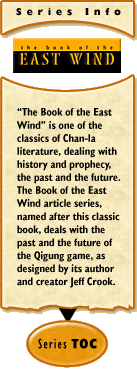 A Slave to Realism
A Slave to Realism
by Jeff Crook
November 20, 2000
In the Conversations, one of the Four Treatises of Chan-la literature, it is written that one day while eating plums in the garden of the emperor, Prince Xi Xushang asked his advisor, the great philosopher Ts’ao Ts’ung, who was himself a disciple of the immortal Dhao, "Master, I have fallen in love with the daughter of Prelate Ting of Wapo province, yet Wapo seems a thousand li from Shidao. How then shall I make her mine? I am but a concubinal son of the emperor, while she is promised to the prelate of Shangxao."
Ts’ao Ts’ung answered, "My Lord Prince, the road to Wapo begins at the garden gate."
A journey of a thousand li begins with the first step. But in what direction? Shall I begin by talking about the creation of the world itself, about the rise and fall of empires, about the wars of gods and demons? Or shall I begin in the garden with a plum and a beautiful girl a thousand li away?
I prefer the garden and the girl.
Taking the above excerpt, I can begin to tell you something about the empire of Chan-la and its people. First there is the matter of the li. The Chan-la mile is called a li, and it is shorter than the modern mile, being only 4,800 feet or 1,600 yards. The li was devised in the days of the building of the Eastern Wall. It was determined that a bowman could cover an area roughly 600 feet in radius from the top of the wall's towers, therefore a small tower surmounts the wall every 1,200 feet. Every fourth tower is taller than its counterparts. The distance between each tall tower then is 4,800 feet, and thus the li is a measurement between each tall tower of the Eastern Wall.
The li, therefore, was established as a well-defined logistical measurement for troops patrolling the top of the Eastern Wall. A celestial general needing troops at a particular point along the wall could know fairly accurately how long it would take to move his troops to that position. An average soldier can march the distance between 40 tall towers, or 40 li, in a single day.
So, if Prince Xi had a journey of a thousand li ahead of him, it would take him about 25 days to reach his ladylove. No wonder he was daunted! But what about Prince Xi? He admits that he is a concubinal son of the emperor, which means that there are concubines. It also means that, although he is the son of a concubine, he is still a prince, but obviously a minor one, as he seems to feel his prospects of winning the heart of the prelate’s daughter are slim because she is promised to the prelate of Shangxao province. A prelate is much lower on the social ladder than a prince, yet apparently not lower than a concubinal prince.
Of course, the idea of concubinage is one that might raise a few eyebrows among players. Fear not, ladies, for there are male as well as female concubines in Chan-la. There are also eunuchs, so that ought to keep the guys in line. In Chan-la, slavery itself is a respected institution, as ancient as the empire.
This is a touchy subject, I know. But even the slaves of Chan-la have rights, including the right to marry, to worship, to not be separated from their children before they are sixteen years old nor to ever be separated from spouses, and most importantly the right to purchase their freedom at a price set by a government institution.
Slaves do not toil at wearisome labor like farming, for that would rob rice from the mouths of the peasant class. For the most part, slaves are employed as personal bodyguards, handmaidens, butlers, stewards, drivers, porters, footmen, and other services required by the wealthy and the powerful. It is said that the emperor has over ten thousand slaves attending to his needs.
The children of slaves are born into slavery, but the children of concubines are born free, and although they have no rights of primogeniture, they are often treated nearly as well as the legitimate children of their mother’s or father’s owner, as can be seen in the example of Prince Xi.
Eunuchs are also slaves, and for obvious reasons always males. They are trained to protect a lord’s or lady’s concubines, but often rise to positions of considerable power. For example, the imperial eunuch Fen Long led a successful palace uprising and usurped the throne in 277 CE. He was also a tyrant and was ousted three years later by the monks of Lohan. But that is a matter for later discussions.
This was a roundabout way of approaching the subject of slavery. I realize that some people might be opposed to it, even in a fantasy environment. I think it works for this game, and will provide one more layer of social conflict to a society already polarized by wealth, race and class. That, too, is a matter for later discussions.



